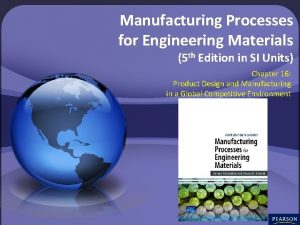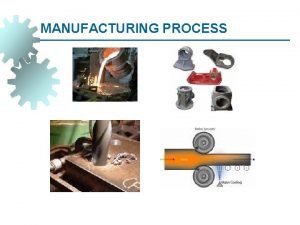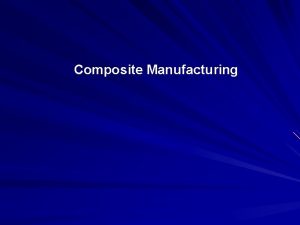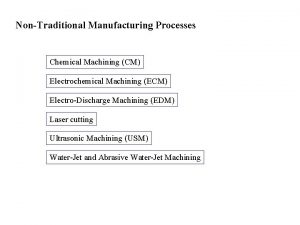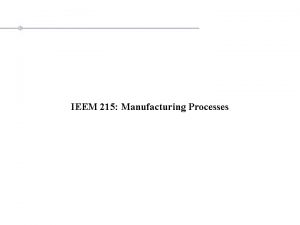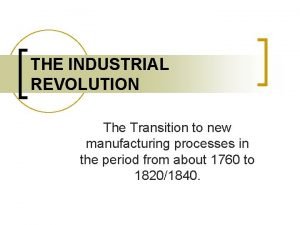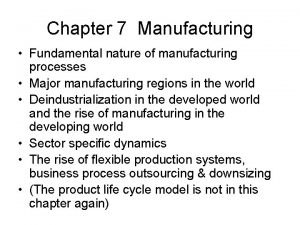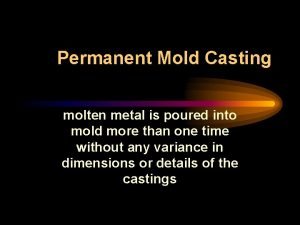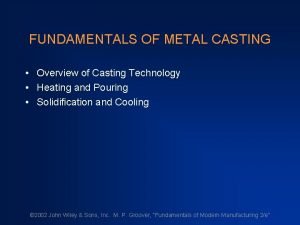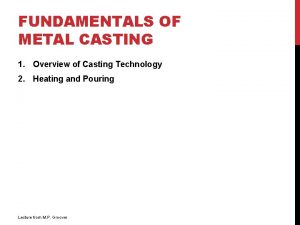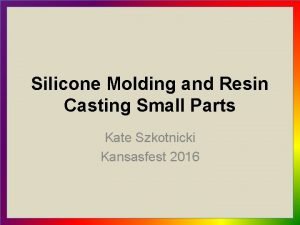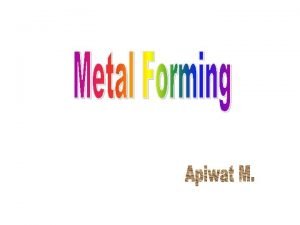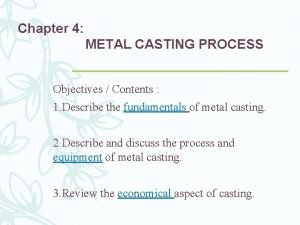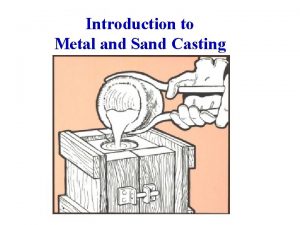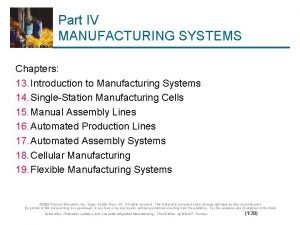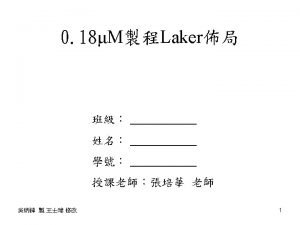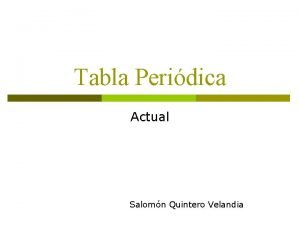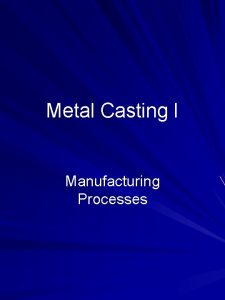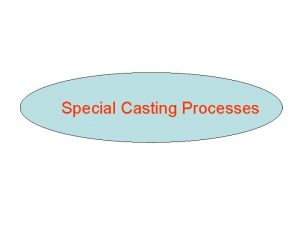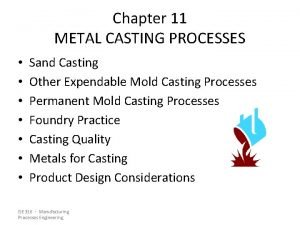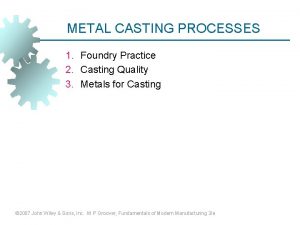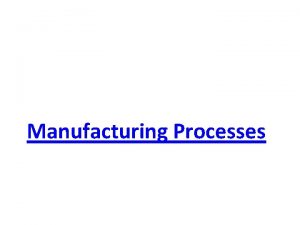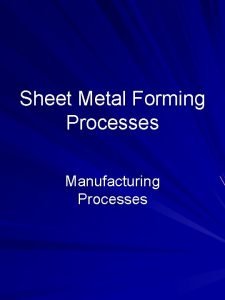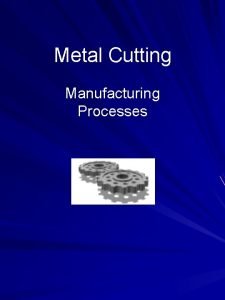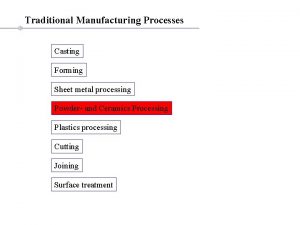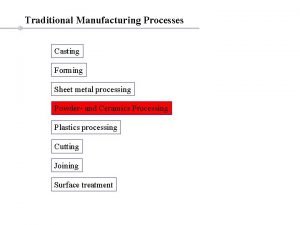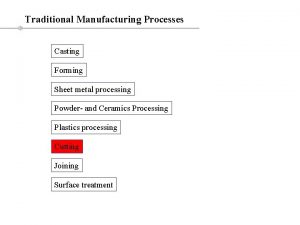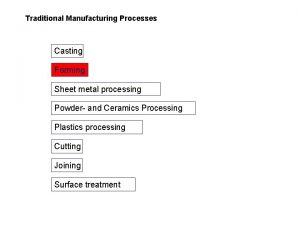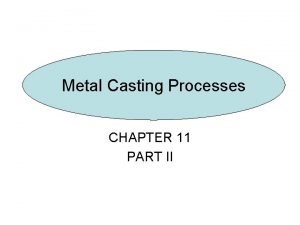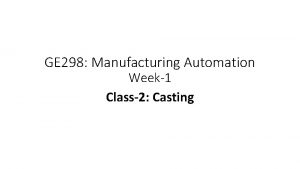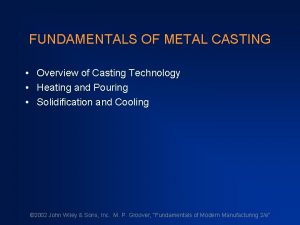Metal Casting I Manufacturing Processes Outline Introduction Metal




































- Slides: 36

Metal Casting I Manufacturing Processes

Outline Introduction Metal Solidification Fluid Flow Fluidity of Molten Metal Heat Transfer Casting Defects

Introduction Casting Pouring molten metal into a mold shaped after the part to be produced, allowing it to harden, and removing it from the mold

Introduction

Introduction - Can be used to create complex internal and external part geometries - Some casting processes can produce parts to net shape (no further manufacturing operations are required) - Can produce very large parts (cast parts weighing over 100 tons have been made) - Can be used with any metal that can be heated to its liquid phase - Some types of casting are suited to mass production

Examples of Cast Parts Crank handle formed by casting; some areas were machined and assembled after casting

Examples of Cast Parts C-clamps formed by casting (left) and machining (right)

Examples of Cast Parts Complex part formed by casting Courtesy of Toth Industries

Forms of Casting and Terminology

Introduction Requirements: - Mold cavity with desired shape and size - Melting process to provide molten metal - Pouring process to introduce the metal into the mold - Solidification process controlled to prevent defects - Ability to remove the casting from the mold - Cleaning, finishing and inspection operations

Casting Terminology Flask The box containing the mold Cope The top half of any part of a 2 -part mold Drag The bottom half of any part of a 2 part mold Core A shape inserted into the mold to form internal cavities Core Print A region used to support the core

Casting Terminology Mold Cavity The hollow mold area in which metal solidifies into the part Riser An extra cavity to store additional metal to prevent shrinkage Gating System Channels used to deliver metal into the mold cavity Pouring Cup The part of the gating system that receives poured metal Sprue Vertical channel Runners Horizontal channels

Casting Terminology Parting Line / Parting Surface Interface that separates the cope and drag of a 2 -part mold Draft Taper on a pattern or casting that allows removal from the mold Core Box Mold or die used to produce cores Casting The process and product of solidifying metal in a mold

Metal Solidification Pure Metals / Alloys Cooling Rate

Pure Metals / Alloys Pure metals solidify at a constant temperature; alloys solidify within a temperature range

Metal Solidification A nucleating agent (inoculant) is a substance that induces grains to nucleate and form at the same time throughout the structure.

Cooling Rate Rapid cooling produces equiaxed (roughly round) grains Slow cooling towards the interior forms long columnar grains that grow towards the center

Metal Solidification Dendrites Tree-like structures that form during the solidification of alloys Slow cooling rates produce dendrites with larger branch spacing; faster cooling rates produce finer spacing; very fast cooling rates produce no dendrites or grains

Metal Solidification

Metal Solidification

Metal Solidification

Fluid Flow Metal is poured through a pouring cup Risers hold and supply metal to prevent shrinking during solidification Gates are designed to prevent contaminants from reaching the mold cavity

Fluidity of Molten Metal Fluidity The capability of a molten metal to fill mold cavities Viscosity Higher viscosity decreases fluidity Surface tension Decreases fluidity; often caused by oxide film Inclusions Insoluble particles can increase viscosity, reducing fluidity Solidification pattern Fluidity is inversely proportional to the freezing temperature range

Fluidity of Molten Metal Mold design The design and size of the sprue, runners, and risers affect fluidity Mold material and surface Thermal conductivity and roughness decrease fluidity Superheating The temperature increment above the melting point increases fluidity Pouring Lower pouring rates decrease fluidity because of faster cooling Heat transfer Affects the viscosity of the metal

Fluidity of Molten Metal

Heat Transfer The metal that solidifies first is at the wall of the mold; this solid layer thickens as time passes Shrinkage during cooling can change the part dimensions and sometimes cause cracking; it is caused by the metal’s thermal expansion properties and the phase change between liquid and solid.

Heat Transfer

Heat Transfer

Casting Defects A. B. C. D. E. F. Metallic Projections Cavities Discontinuities Defective surface Incomplete Casting Incorrect dimensions or shape G. Inclusions

Casting Defects

Casting Defects Porosity may be caused by shrinkage and/or gases Thin sections solidify faster than thick sections; therefore the molten metal cannot be supplied to thick regions that are solidifying Gases become less soluble in a metal as it cools and solidifies, causing it to be expelled and sometimes form or expand porosity

Casting Defects

Casting Defects Chills Pieces of material placed in the mold to speed up heat transfer in thicker areas of the part to prevent shrinkage porosity Internal chills are left within the cast part; external chills are removed

Chills

Summary Casting involves melting metal and allowing it to solidify in the desired shape Casting allows the creation of parts that would be difficult or uneconomical to make by machining

 Introduction to manufacturing processes
Introduction to manufacturing processes Manufacturing cost vs non manufacturing cost
Manufacturing cost vs non manufacturing cost Job order vs process costing
Job order vs process costing Uncontrollable cost example
Uncontrollable cost example Manufacturing cost vs non manufacturing cost
Manufacturing cost vs non manufacturing cost Additive manufacturing vs subtractive manufacturing
Additive manufacturing vs subtractive manufacturing Manufacturing process for engineering materials
Manufacturing process for engineering materials Classification of manufacturing
Classification of manufacturing Composite manufacturing process
Composite manufacturing process Nontraditional manufacturing processes
Nontraditional manufacturing processes Traditional manufacturing processes
Traditional manufacturing processes The transition to new manufacturing processes
The transition to new manufacturing processes Nature of manufacturing process
Nature of manufacturing process Concurrent in os
Concurrent in os The process of pouring molten metal into molds
The process of pouring molten metal into molds Fundamentals of metal casting
Fundamentals of metal casting Fundamentals of metal casting
Fundamentals of metal casting Resin casting small parts
Resin casting small parts Classification of casting
Classification of casting Bulk deformation and sheet metal forming
Bulk deformation and sheet metal forming Objective of sand casting
Objective of sand casting Sand casting introduction
Sand casting introduction Sandwich quote example
Sandwich quote example Hong xiao semiconductor
Hong xiao semiconductor Manufacturing company introduction
Manufacturing company introduction Introduction to manufacturing systems
Introduction to manufacturing systems Stochastic process
Stochastic process Venn diagram of 3 states of matter
Venn diagram of 3 states of matter Metal vs nonmetal
Metal vs nonmetal Dp periodic table
Dp periodic table Melting point of nonmetals
Melting point of nonmetals Pmos nwell
Pmos nwell Uses of non-metals
Uses of non-metals Substances
Substances When a metal reacts with a nonmetal the metal will
When a metal reacts with a nonmetal the metal will Periodo en quimica
Periodo en quimica Blanch def
Blanch def






